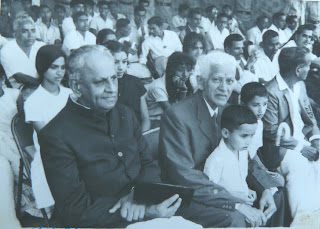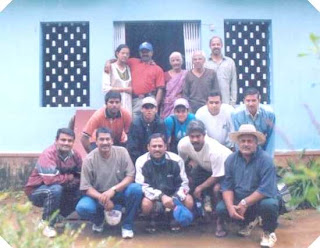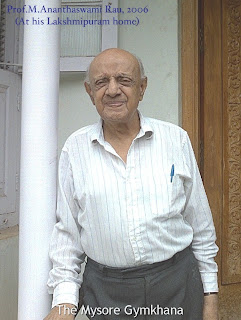THE MYSORE GYMKHANA - a thumbnail historical sketch
K.R.DINAKAR
[Written in April 2003. Published in Star of Mysore and Deccan Herald in July 2003]
Auspicious beginning
One of Mysore's typical cultures is the "katte culture". A "katte" is usually a stone bench where a group of people sit, relax and chat on all topics under the sun and spend the evening. Such places are often birthplaces of amazing things. The scene is from 1936 and the venue, the stone steps of the University Union building (now housing the Graduate Library) in the Maharaja's College Campus. The group of people in this case, were enthusiastic sportsmen with multifarious talents feeling the need for a regular club where they could join together and hone them. What t ranspired from a discussion there one fine evening was the formation of a club which was eventually named as THE MYSORE GYMKHANA (TMG). M.Ananthaswami Rau, now 87, was witnessing that historic discussion. The lamp had been lit.
[This is the very 'katte' where it all began - pictured in 2006]
Responsible menThis write-up will not do full justice to the responsible men who were instrumental in putting invaluable oil to the TMG lamp, if they are left unnamed. Eminent people like CMH Ranajodh Singh, Col.DCN Bahadur, FC Devaraj Urs, A Lingaraj Urs, KM Subba Rao (author's grandfather), VK Srinivasan, MN Parthasarathy (Pachu, who later became a commentator), BS Kesavan, A Narayanaswamy, A Sambamurthy, et al, who were all elder sportspersons and patrons who guided the young group of enthusiastic sportspersons who set the TMG-ball rolling. Sirdar K. Basavaraj Urs consented to be the President and chief patron while CB Jaya Rao, (who was active both in the theatre and sports circles) was acting as the Secretary. At that time, the members were using a ground for their activities where the Crawford Hall now stands. That ground, a part of the vast Gordon Park, was under the control of the Maharaja's College and the then Principal, Prof. J.C. Rollo a great sports-lover himself and a great patron of TMG, had been gracious to permit use of that ground. Prof. Rollo was also the State Cricket Association's first President. (The Maharaja's College/Mysore University have been, even to this day, extending its helping hand to TMG in maintaining that old legacy.)Rau, the living witnessThough the activities of TMG had begun in 1936, it was only on June 24, 1941, that the first GBM was held and the bye-laws were newly constituted. M.Ananthaswami Rau (now 87 and standing as straight as ever) was formally elected as the Secretary. In 1946, Rau was successful in the first ever Cricket Umpires examinations conducted by the state cricket association. (ML Nanjaraj Urs was the other member who held that distinction). Mr. Rau went on to officiate many first class cricket matches later on and was in the all-India panel for a decade. He was one of those much respected gentleman-umpires.
Early Activities
In its formative years, the club's main focus was on Cultural activities (drama/theatre). TMG has won several awards in that circle and participated in various drama competitions. Popular games like Tennis, Basket ball, Football, Hockey, Cricket and Ball Badminton were also encouraged. In 1952, a 'Festival of Tennis' was conducted and a young Ramanathan Krishnan (Wimbledon semi-finalist) was the champion of the event. C.Srikantan (who later became President of TMG) organized the show successfully. HH Sri Jayachamaraja Wodeyar was the chief guest. A unique sandalwood tennis raquet containing a scroll was presented to His Highness.Cricket talent
As years rolled by, Cricket, with its great popularity, began to dominate the activities of TMG. Over the decades, TMG had the good fortune of having been represented by noted and talented cricketers. Just to name a few,
Phiroze Palia (toured England in the historic tours of 1932 and 1936 and played for India in two Test Matches),
Safi Darashah (who had the distinction of bowling the first ever ball in Ranji Trophy, in 1934), Charles Pitchamuthu,
C .J Ramdev ,
AS Krishnaswamy (narrowly missed playing for India) and DM Engineer had represented the erstwhile Mysore State in the Ranji Trophy. In recent times,
S.Vijayprakash and
AK Raghu represented Karnataka in the Ranji Trophy. But
Javagal Srinath went even higher than all others and played 67 Tests (so far) and over 200 ODIs for India. If those are the ones who succeeded in going higher, there have been several very talented ones who could not do so. Nonetheless, they are all stars in their own right and rare jewels studding the TMG crown.
"Combined XI" - Tennis Ball Cricket Team
Tennis ball cricket had become popular in the 1960s and many members of the TMG, esp. the younger bunch had taken to it. It was usually played on the streets as well as in a small open space that was available behind the "Mission School" situated in the corner of the Vani Vilas Road - Geeta Road intersection. Cricket with the tennis ball demands high skill. Many of the members had become exponents in fielding, batting and bowling, which was proved by the fact that this team under the name of "Combined XI" (almost an off-shoot of TMG) was nearly unbeatable in the tournaments and the 'friendly' matches that took place in great abundance. It is said that people used to come and watch this team in action. Such was the level of cricket! Tennis ball cricket, being easily affordable, compared to the real version, helped keep up the interest among the members. This interest and skill in unison, got automatically carried over to the real version of the game.Re-climb to the pinnacleThere are always ups and downs in any success story and TMG's is no exception. There was a time in the 1960s and early 1970s when TMG's performances had slumped for various reasons. But slowly and calmly, it regained composure and stood up to face the challenges again from the platform of the 5th division in the State league in 1975-76. In the meantime, TMG had found a new place (popularaly known as 'old NIE') for conducting its cricket practice sessions. On 31.12.1970, Capt. H.Veeraraj Urs, the then Director, Physical Education Dept. of the Mysore University inaugurated the new practice wicket by bowling the first ever ball there. This important facility provided a great impetus and henceforth, there was a steady upsurge in its spirit and stature while talent became abound, quite naturally. As quickly as 1977, TMG had risen to the 4th division. By 1984, through consistent performances and perseverance, it reached the pinnacle, ready to take on the best teams in the first division. It did so admirably well and showed the opponents in the state league its real worth. In 1989-90, The KSCA reorganized its format and the new zonal basis of the league came into force.Recent achievementsIn the new zonal format (since 1989-90), TMG has so far been impervious in the first division (Sri Jayachamaraja Wodeyar Shield) in the Mysore Zone. It is proved by the fact that it has been winning every time till 2002-2003, a truly remarkable feat. In the prestigious M.Gopalswamy Memorial Tournament, TMG has been a frequent 'finalist' over the years, having won it a number of times in the past. It is now the present holder of this shield too. Such a highly sustained performance also brings to limelight, the team-spirit, hard work and sincere efforts that the players put in under the eagle-eye supervision of TMG's vice-president, C.S.Subramaniam and other dedicated senior members. In the year 2000, the KSCA organized a "Champions Trophy" for the winners of the 6 zones of the state who challenged the top 2nd division teams of Bangalore Zone. TMG beat them all and won that as well.Cricket toursBeing one of the oldest clubs in the state and also TMG's high reputation earned over the decades have been great factors in getting invitations to participate in various recognized tournaments. In 1952, TMG toured Vijayawada on invitation from the Raja of Venkatagiri and played matches there. In recent years, it has participated in prestigious All-India and State level tournaments like the City Union Bank trophy at Kumbakonam (Runner-up twice), Lakshman Memorial at Kochi, Basavangudi Cup and YSR Memorial at Bangalore, YSCA Tournament at Chennai, St.Peter's Trophy at Kodaikanal and other tournaments at Ilkal, Hubli, Hassan and Chickmagalur.Playing hostTMG has proved to be a good host too, almost by tradition. It has the privilege of having successfully hosted teams from Ceylon (now Sri Lanka) and Australia (thrice). In 1989, it conducted the inaugural cricket tournament in memory of the great Safi Darashah, a distinguished member. This is now conducted by the KSCA annually on a higher scale. In 1996, TMG successfully organized an all-India tournament to commemorate its Diamond Jubilee. Then, to commemorate the turn of the last century, with an intent to provide match-opportunities to the under-12/14 boys, it successfully conducted the Y2K Tournament.
Tapping talent
Speaking of tapping young and raw talent almost from nowhere, TMG organizes Summer Coaching Camps for the under-16 boys and the most talented ones are rewarded with 'scholarships'. It has been doing so for the last 19 years. It was in one such recent camp that MR Darshan (represented Vijaya Cricket Club) was attending. He went on to play for India at Sharjah in the under-15 World Cup in 2002.A team to reckon withThe name and fame achieved by The Mysore Gymkhana in cricketing circles speaks volumes of its whole-hearted and sincere efforts to promote the cause of cricket. TMG has been providing gracious encouragement and vistas to its players while keeping the 'spirit of cricket in its true form' very alive. Ever since its inception, history shows that there was no dearth for cricketing talent. TMG was and always has been a team, considered by the opponents as 'one to reckon with'. The still-in-vogue "katte culture" seems to have automatically inculcated team-spirit, a feeling of oneness, a sense of belonging and a family atmosphere, all so essential in any team game to thrive. That probably is the hidden secret of the TMG success story. Let the lamp, lit 67 years ago, keep glowing as brightly as ever and bring laurels to the great game that cricket is.
Post script:
Team spirit - it was an important factor for making this unit such a successful one for such a long time. In my honest opinion and personal experience, it was the "katte culture", that was responsible in bonding players together. The players knew each other well because they spent so much time together at the "Katte" (the one still in vogue, at Gita Road in Chamarajapuram).
~Author






















